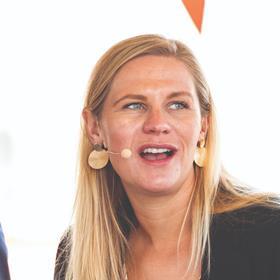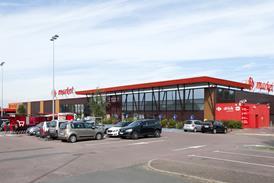As the property sector works to improve its sustainability, with long-term goals of carbon neutrality and nature-positive outcomes, there is a growing awareness that the road cannot be travelled alone.

Expert panellists
- Anita Rivera, partner and head of planning – Mishcon de Reya
- Katherine Beisler, director and head of ESG consulting – Hollis
- Vincent Bryant, chief executive and co-founder – Deepki
- Adam Hart, senior director, segment sales, Europe – ChargePoint
- Julie Emmrich, sustainable finance lead – World Green Building Council
- Niall Bolger, chief executive – London Borough of Hounslow
- Abigail Dean, board member – Better Buildings Partnership; head of strategic insights - Nuveen







The large number of different stakeholders involved in the sector, and their reliance on each other, means that co-operation across various different types of organisations is essential.
Property Week editor Lem Bingley made these observations as he opened the Get Set for Net Zero Brunch event, held in partnership with consultancy Hollis at a sunny rooftop venue at Mipim last month.
In a keynote address, Abigail Dean, head of strategic insights at Nuveen Real Estate and a Better Buildings Partnership (BBP) board member, outlined the importance of collaboration to the BBP’s mission.
She said the partnership represented up to 40% of the UK built environment through its various members, with a goal of improving sustainability across their shared portfolio.
“Collaboration is crucial to tackle the challenge of moving the industry towards net zero carbon,” she said. “Real estate is an industry that is quite fragmented, with a range of different organisations playing different roles in it. We need to be able to work together and communicate.”
Dean urged all those in attendance to put aside their usual competitive instincts in the face of the climate crisis, to “share best practice and come up with tangible actions” to help move the sector forward. “On sustainability, it really takes us all to come together and work together,” she added.
Landlord-occupier relationship
Collaboration between building owners and occupiers is arguably the most vital starting point to ensure progress is made towards decarbonisation.
“Where historically there was tension and a lack of conversation between the two, this is a topic they can now collaborate and agree on,” observed Katherine Beisler, director and head of environmental, social and governance (ESG)consulting at Hollis, during a panel debate at the event.
She added that agreeing key performance indicators (KPIs) that are meaningful for both sides is an important step.
“We are starting to see that more and more, which is both exciting and helpful for the conversation, because we can all move in the same direction of travel.”
Vincent Bryant, chief executive and co-founder of market-leading ESG data intelligence firm Deepki, said that even 10 years ago, it was typical to see real discord between owners and occupiers around decarbonisation, with both sides tending to shirk responsibility or blaming each other for a lack of investment or progress.
“But now we see that they do have an interest in working together to make it happen for several reasons,” Bryant said, citing a variety of factors including the value of assets, access to capital for building improvements, the impact on occupiers’ operational costs and the importance of sustainability in attracting and retaining talent.
However, Bryant added that more remained to be done, particularly on the occupier side. While a building can be market-leading in its sustainability measures, if occupants ignore best practice on heating, lighting and ventilation, real-world results may fall behind.
“We need to create sustainable practices so that tenants and users of a building behave better in the way they use the building,” he said. “Sometimes we forget that this implies much more than just switching off the lights before leaving the building. It can mean using the stairs instead of lifts, or having a lower temperature. It requires a huge amount of commitment, communication and education to work.”
Adam Hart, a senior sales director for Europe at ChargePoint, a leading provider of networked charging equipment for electric vehicles, agreed that there was “100% more alignment” between landlords and occupiers than there was in the recent past.
“The phrase ‘mutual interest’ is a good one to describe the current relationship,” he said.
However, he added that there were still tensions. “We find often the difficulty is how to project into the future,” he noted.
“If you are an occupier, and the lease doesn’t run long enough [to ensure return on investment], you’re having a conversation with the owner about who is investing, who is putting forward the capital to make upgrades possible.”
Green financing
The journey to net zero is not only changing relationships between landlords and occupiers, but is also revolutionising how the financial world views real estate. In a bid to future-proof investments and get the best return on their investments, banks are favouring those who can demonstrate assets delivering best-in-class sustainability.
Beisler said: “We speak a lot to banks, lenders and financers about whether there is any incentive or benefit to meeting certain environmental targets or incorporating certain KPIs and the answer has been ‘definitely’.
We need to create sustainable practices so that tenants and users of a building behave better in the way they use the building
“In recent years, banks have really developed their sustainable financing and green loan structures, setting solid KPIs in terms of ESG targets that, if met, [would mean] they’d give better interest rates on loans.”
Julie Emmrich, sustainable finance lead at the World Green Building Council, added: “There is increasingly appetite from financial institutions to be more actively engaged with the industry when it comes to net zero.”
Net zero targets and profit
Anita Rivera, partner and head of planning at law firm Mishcon de Reya, agreed that the interests of borrowers and lenders had begun to align, but that both were often frustrated in their sustainability goals by the planning system.
“Developers really reflect the market; they reflect what their funders want, as well as their own ESG agenda,” she said. “You have a lot of developers who are really keen to build sustainable buildings, but the problem is that planning is not cheap. It’s very lengthy and it’s very uncertain. For funders, developers and investors, when they get to the planning stage, they face a pinch-point over whether there is that trust in the system.
“Having invested all that time and money, they need to know whether the system will allow them to proceed within a realistic timeframe, so that the developers will get their profits and the investors will get their returns.”
Rivera added: “When we talk about collaboration, it really needs to happen with the local authority planning officers.”
Niall Bolger, chief executive at the London Borough of Hounslow, denied that planning was inefficient, preferring to describe it as complicated.
He added: “We need to ensure we have early engagement, and as often as possible. That is the best solution to getting rid of planning risk – talking to planning authorities about your ideas and having open conversations before you submit an application.”
He added that environmental scrutiny of applications is bound to tighten: “Authorities across London are going to be even tougher on sustainability targets, both in terms of new development but also retrofitting.”
But Bolger said planning authorities don’t want to have adversarial relationships with developers, and common ground can be found to create better buildings, neighbourhoods and communities, while also delivering profit and returns for investors.
“Progressive authorities recognise the need to collaborate across sectors and make sure we have common interests in making places better,” Bolger said. “We will be entirely open to having discussions about how we can make places better. But we recognise that our colleagues in the private sector are there to make a profit, so what we need to do is work in that collaborative space.”
While the panellists aired different views about the roadblocks, all agreed that collaboration was paramount for the real estate sector to reach net zero, particularly through the sharing of insights, digital data and lessons learned.
The UK real estate industry can drive systemic change, reduce carbon footprints and create a sustainable built environment for future generations – but only through industry teamwork.
WATCH THE VIDEO:
































No comments yet